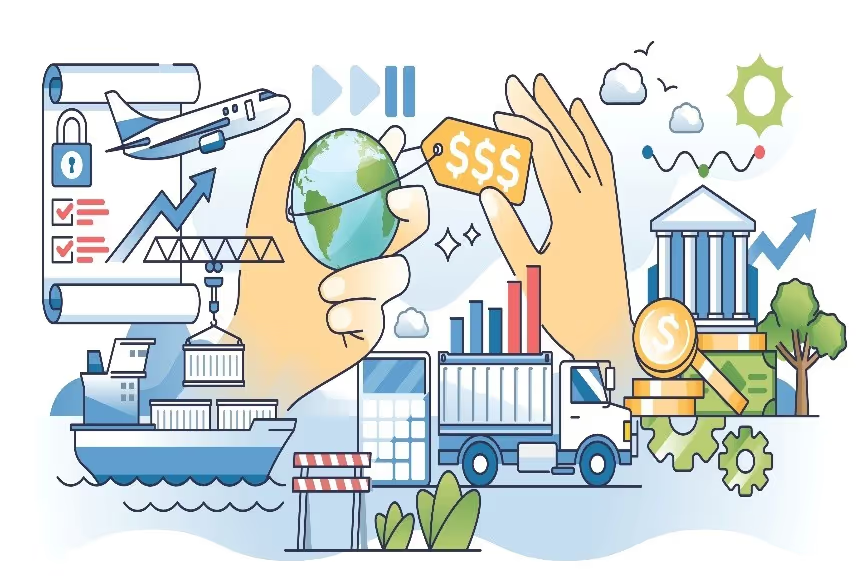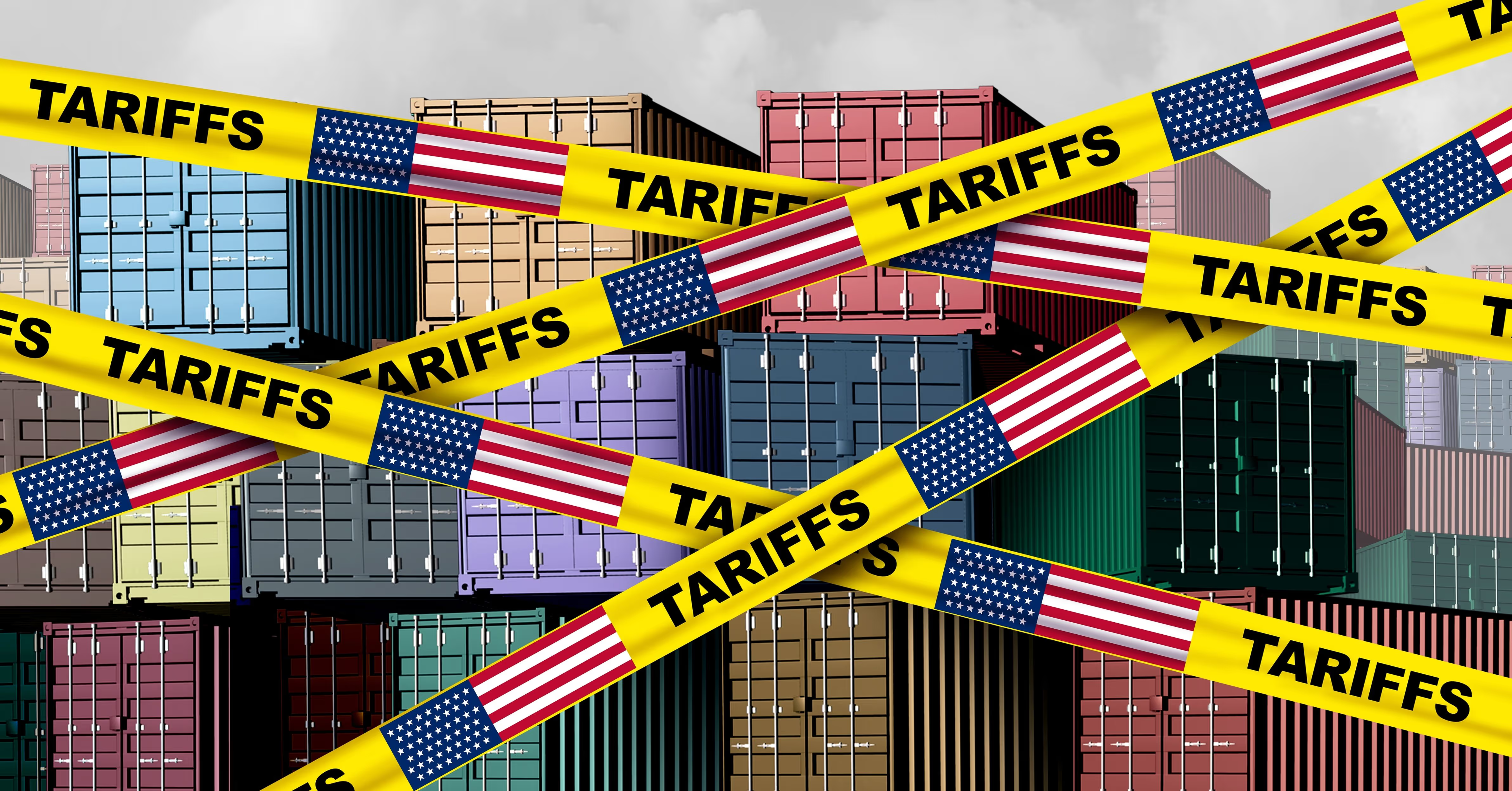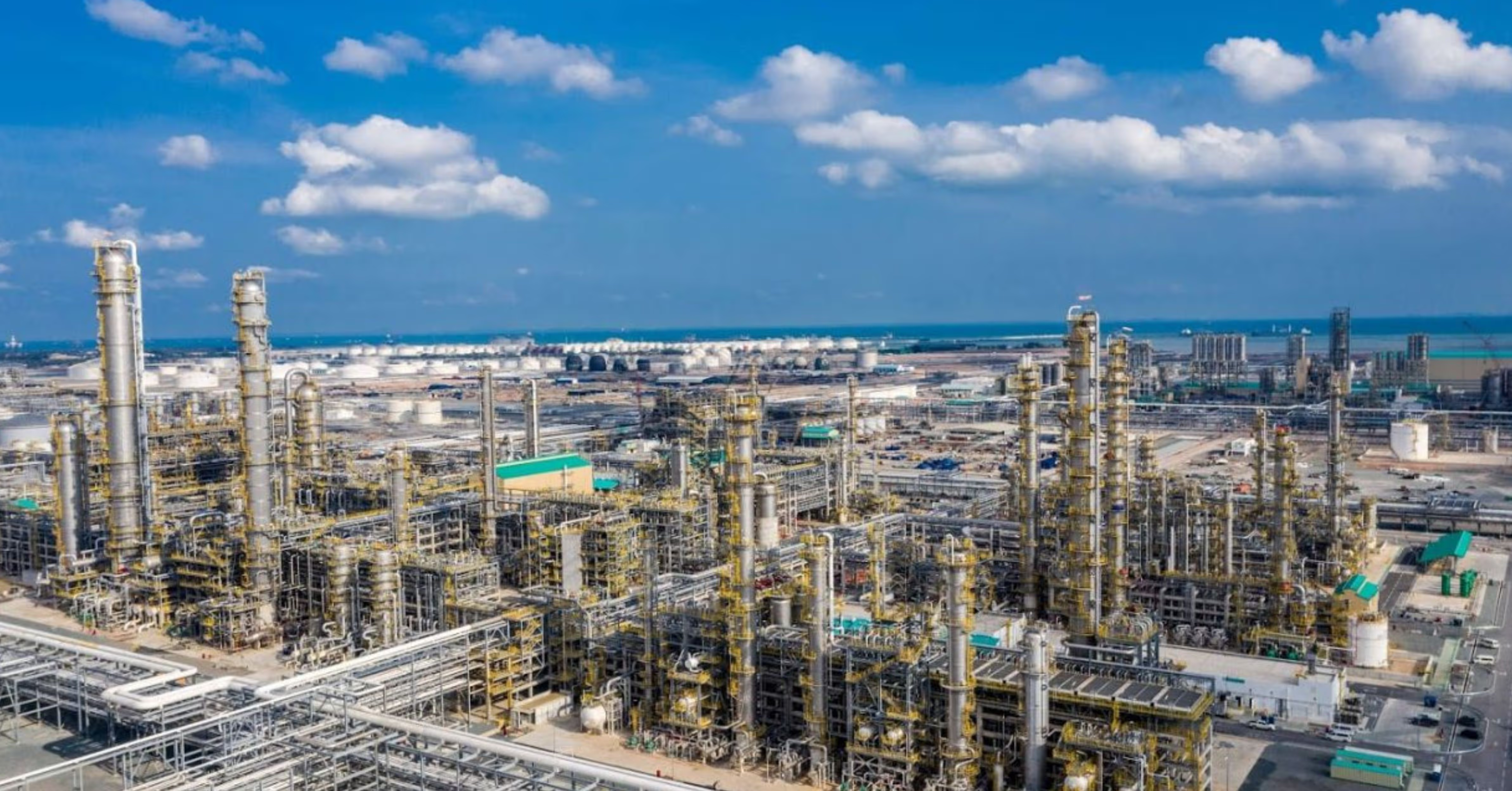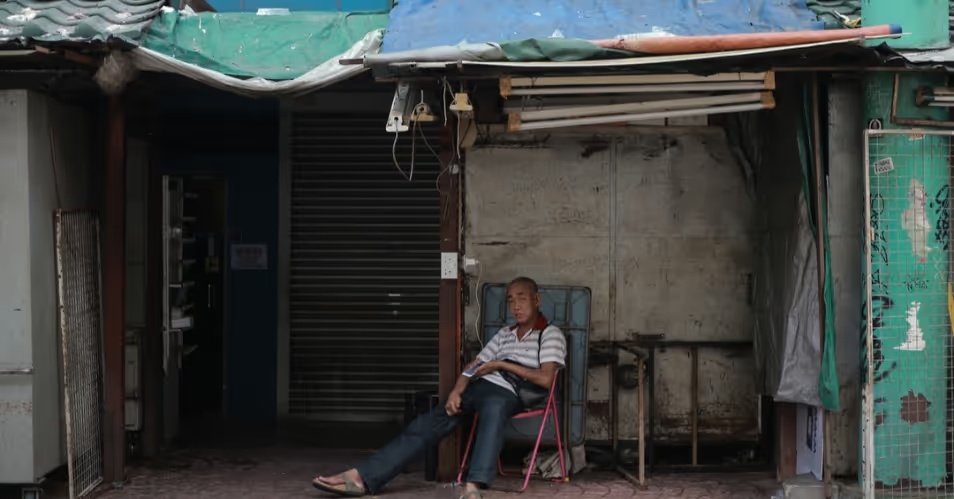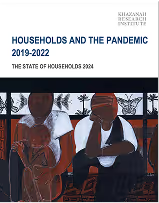
Introduction
On 26 October 2025, President Trump and Prime Minister Anwar Ibrahim signed the Agreement between the United States of America and Malaysia on Reciprocal Trade (ART)1.This agreement covers multiple issues such as tariffs, digital trade, economic and national security, and state-owned enterprises (also known as government-linked companies in Malaysia).
However, tariffs covered by the ART are only part of the story on US tariffs that apply to Malaysian exporters. The ART mainly covers the Reciprocal Tariff Rate (commonly referred to as the Trump tariffs). In addition to the Trump tariffs, Most-favoured Nation (MFN) Tariff Rates apply regardless of whether the Trump tariffs are 0% or higher. Additionally, the US employs other policy tools to impose tariffs on Malaysian imports. These tariffs are sometimes ‘stacked’ on top of each other. Thus, as multiple policy tools are used by the US to impose tariffs, the same product can face multiple tariffs ‘stacked’ on top of each other[2].In practice, as the Trump Administration issues multiple Executive Orders in relation to the Trump tariffs, there is a possibility that the multiple Trump tariffs may also be ‘stacked’ and thus applied cumulatively[3].For example, an item may face an MFN Tariff Rate, a Trump tariff and a national security tariff under Section 232. Thus, a product may have cumulative duties that affect its final effective rate[4].
This article aims to examine the various types of tariffs applicable to Malaysian exporters. Specifically, these tariff scan be applied cumulatively as they are ‘stacked’ on top of each other. This article also highlights tariffs that may apply to Malaysian exporters in the future. As the Trump tariffs are currently being contested in domestic US courts, the outcome of these cases would have an impact on Malaysian exporters. This article aims to connect the implications of the ongoing US Supreme Court case regarding Trump tariffs to the ART. This article is intended for educational purposes only and should not be considered legal advice.
How Tariffs are Stacked
Table 1 below illustrates the stacking of tariffs and identifies the sectors where this practice is currently observed. It is important to note that while Table 1 provides an overview of sectors affected by specific actions, each policy tool will clearly specify the applicable product codes. To fully understand how a tariff is ‘stacked’ on a particular product, it is essential to identify the specific product codes associated with each policy tool. A single product category can encompass hundreds, or even over a thousand, tariff lines.
Table 1: The ‘Stacking’ of the Different Types of Tariffs that Apply to Malaysia

Note: The simple average tariff is the unweighted average of the ad valorem or ad valorem equivalents (AVEs) of MFN applied or preferential tariffs, including tariff actions, based on pre-aggregated HS six-digit averages.
The US can use multiple policy tools to impose tariffs. Three such policy tools are explained below.
Section232. As mentioned in Table 1 above, the US currently uses Section 232 investigations to impose tariffs. Section 232 investigations are conducted under the US Trade Expansion Act of 1962 by the US Department of Commerce5.The purpose of the investigation is to “determine the effect of imports on the national security”[6]. Criteria that are considered in the investigation are:
· “requirements of the defence and essential civilian sectors;
· growth requirements of domestic industries to meet national defence requirements;
· quantity, quality andavailability of import;
· impact of foreign competition on the economic welfare of the essential domestic industry;
· the displacement of any domestic products causing substantial unemployment, decrease in the revenues of government, loss of investment or specialised skills and productive capacity; and
· other factors relevant to the unique circumstances of the specific case” 7.
Investigations can last up to approximately9 months from the date of initiation of the investigation. After this period, the US President will decide whether to agree with the investigation's recommendations. For example, in the case of the ongoing investigations on semiconductors, investigations were initiated on 1 April 2025, which means that the investigation should conclude by the end of 2025[8].
Section301. The US Trade Act of 1974 has a specific section on ‘Relief of Unfair Trade Practices’, known as Section 301. The Office of the United States Trade Representative (USTR) is responsible for investigating and taking action, such as imposing tariffs, to uphold US rights under trade agreements and address specific foreign trade practices. The scope of investigations can be quite broad to include services and investments. The Trump Administration has initiated investigations related to the practices of China, Nicaragua and Brazil[9].
Section122. The US Trade Act of 1974 has another specific section (Section 122) that allows the President to impose tariffs when there isa large and serious US balance of payment deficit or a fundamental international payments problem[10].It is important to note that Section 122 has never been used, although the White House has indicated interest in using this policy tool[11].Tariffs under this mechanism are set at a maximum of 15% for a maximum of 150days[12].
Tariffs and the US Supreme Court
It is noteworthy that the Trump Administration’s actions, particularly in relation to the Trump tariffs, have been challenged in the US domestic courts. However, the tariffs remain in place as the US Supreme Court reviews the cases that argue that the President had exceeded the scope of his authority by imposing these tariffs[13].Specifically, the Trump Administration had used the International Economic Emergency Powers Act of 1977 (IEEPA) as the basis for imposing the Trump tariffs, which is now being challenged. It is hard to tell how long it will take for the US Supreme Court to issue its judgment[14].However, one analyst expects a definitive US Supreme Court ruling by end-2025as this case is on an expedited track[15].This article explores two key scenarios moving forward:
· Scenario 1: The US Supreme Court rules in favour of the Trump Administration.
· Scenario 2: The US Supreme Court finds that the Trump tariffs (Reciprocal Tariffs) are illegal under IEEPA.
Table 2 below provides a summary of the possible impact of the US Supreme Court case on Malaysian exporters.
Table 2: Possible Impact of the US Supreme Court Case to Malaysian Exporters
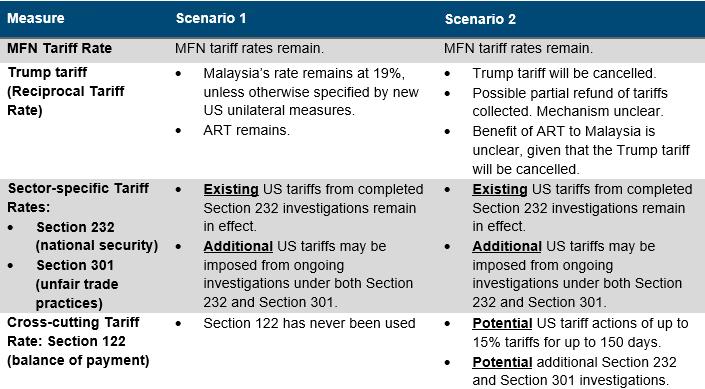
Scenario1: If the Supreme Court rules in favour of the Trump Administration, the ART remains intact, and the benefits of Malaysia negotiating for a lower Trump tariff of 19% remain. Nevertheless, there is a possibility that the US may unilaterally impose tariffs on Malaysia, particularly its ability to ‘stack’ the different types of tariffs applicable to Malaysia. For example, although semiconductor products are currently not subject to the Trump tariffs, they fall under an ongoing Section 232 investigation. Thus, there is uncertainty on whether the US will impose additional tariffs on semiconductor products in the future. Under the ART, the US had retained policy space to impose “additional tariffs to remedy unfair trade practices, to address import surges, to protect its economic or national security, or for other similar reasons consistent with its domestic law”[16].
Scenario2: If the Supreme Court determines that the Trump tariffs (Reciprocal Tariffs)are illegal, the Trump Administration will be hampered from introducing tariffs on short notice[17].This is because other policy tools available to impose tariffs, such as Section232 and Section 301, require investigations to take place first. Thus, Malaysian exporters may face a brief reprieve from Trump tariffs as the Trump Administration seeks to impose tariffs through other policy tools. Nevertheless, this reprieve may not be long as the White House has indicated that it would not be deterred if it loses, using policy instruments that allow the President to impose up to 15% tariffs for up to 150 days[18].Once again, ‘stacking’ of tariffs is still possible in this scenario.
In Scenario 2, the US Treasury Secretary has indicated that the US may have to refund the tariffs collected since the start of President Trump’s current term[19].This could involve tens of billions of dollars; however, the process for implementing this remains unclear due to the complex logistics that would need to be established[20].
In the case of Malaysia, the next steps for the ART to be fully enforceable are for both countries to ratify the agreement, after which it will enter into force 60 days later. In essence, this agreement will only be fully enforceable in 2026, although the US has already lowered its Trump tariff to 19% for Malaysia. As the ART did not require Malaysia to amend existing laws before signing, the ratification process may be speedy[21].Nevertheless, Scenario 2 may still present an opportunity to rebalance the ART and renegotiate the agreement's terms, given the primary benefit of reduced Trump tariffs is not there. This possible opportunity to rebalance the agreement may be the reason why the European Union(EU) is seen to be waiting for the outcome of the Supreme Court case before ratifying its agreement with the US[22].
Conclusion
Tariffs imposed on Malaysia’s exports to the US should be understood as part of a phenomenon known as ‘tariff stacking’, where multiple types of tariffs may apply to the same product. The ART primarily covers the Trump tariffs for Malaysian goods going to the US. However, ongoing investigations in the US may lead to further tariffs on specific sectors of Malaysian exports. Thus, Malaysian exporters need to be aware of how ‘tariff stacking’ is applied for each product and the sectors that may face additional tariffs in the future.
Further, the US Supreme Court is set to rule on the legality of the Trump Administration’s Reciprocal Tariffs. This ruling will have an impact on the tariff rates applicable to Malaysian exporters. It is hard to tell how long it will take for the Supreme Court to issue its judgment, although this could be as early as the end of 2025. If the Supreme Court rules in favour of the Trump Administration, the ART would remain largely intact. However, if the Supreme Court deems the Reciprocal Tariffs illegal, this may present an opportunity for Malaysia to rebalance the ART and renegotiate the agreement's terms.






